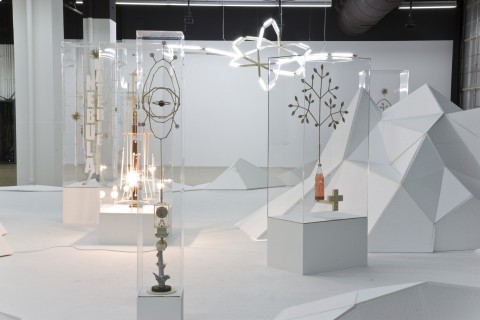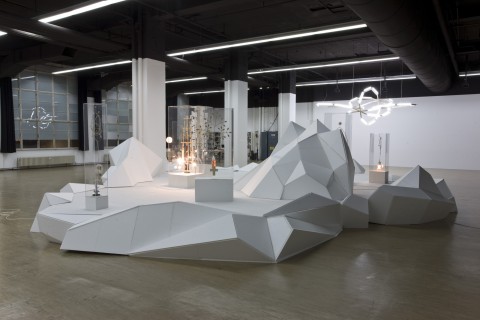Björn Dahlem The Island
Following Im Krypton (2004) and The Milky Way (2007), the Guido W. Baudach Gallery is delighted to present its third solo exhibition by Björn Dahlem. In his work, this Berlin-based sculptor, who was born in 1974, draws thematically in equal measure on physics and astronomy, and on the realms of philosophy, religion or science fiction. Dahlem fuses both concrete and imaginary cosmologies to forge fantastical theoretical models, which, rather than aspiring to depict a faithful illustration of any specific phenomena, allude to the narrative potential of their inherent world views. These complex, frequently abstract intellectual constructs usually find their material expression in fragile, often seemingly weightless structures, fashioned from mundane DIY materials and quotidian items.
In this current exhibition, entitled The Island, Dahlem transforms the gallery into an “architecture of the heavens”. Its central object, a crystalline-shaped island, expands meanderingly across the room. Attended by a small rock formation and a “dwarf galaxy”, it bespeaks the “grand totality”, namely the universe. This island, an elevated plain, harbours various self-contained “holistic world models”, presented in glass display cabinets, which thus become interconnected. Common to all these works is that their titles, such as Himmelsglobus (Das Weltall), Milchstraße or Geist, deliberately avail themselves of phenomena or concepts, which by virtue of their universality and high degree of abstraction remain somewhat elusive. This intention is clearly illustrated in the work Geist, which boasts a conglomeration of such terms as “Nebula”, “Pseudologia”, “Mysterium”, “Freude”, “Mare Crisium”, “Black Hole” or “Materie”. The objective of assigning these concrete names is not to furnish a categorical explanation of the work, but rather to reinforce the complexity of levels of meaning in art, to forge a potential openness, which, notwithstanding ostensibly irreconcilable contradictions, strives to “dis-close” the world. For even the island itself, replete with its myriad sub-units, only forms part of a very much larger mysterious universe. What at first glance appears as a representation of scientific phenomena, quickly reveals itself to be a platform, on which Dahlem is negotiating something very different: namely, the hermeneutic notion of achieving an holistic understanding of the world, in which science and art – usually perceived as two distinct systems of knowledge– merge. Science here is applied as an instrument to observe nature, and is possessed of the capacity to highlight the creative principle, the wonder and the beauty of the natural world. From this perspective, the central and titular motif of the exhibition, The Island, can be interpreted as a place of retreat, refuge or a projection, and thus as a romantic topos par excellence. And it is no coincidence that this island – built from polygonal Styrofoam elements – not only resembles a futuristic, spaceship-like, rescue capsule, but is also reminiscent of Caspar David Friedrich’s painting The Sea of Ice (The Wreck of Hope) from 1823/24.
The legacy of the Romantic era and its consequential manifestations in the art of the 20th century, such as Joseph Beuys’ “extended concept of art”, who set out to re-unite the “cold” and the “warm” poles of the world, namely science and art, following a long period of supposed disjunct, are equally reflected in Dahlem’s works, as is the modernist project of transforming banal items into something sublime by transferring them into the context of art. Here art and science, creativity and rationalisation coalesce into a harmonious, synthetic entity. Dahlem’s presentation in the gallery may be read as a kind of symbolisation of this principle: the crystalline form of The Island reflects the cold pole, the cosmological models in the display cabinets – enshrouded by a mysterious aura – the warm pole. Yet at the same time, they appear in the round as a vast entity, in which the small and the large units continually form a structural complement to each other.
Some group exhibitions Björn Dahlem has taken part in: Fabricateurs d’espaces, Institut d’art contemporain, Villeurbanne (2008) / Vertrautes Terrain – Aktuelle Kunst in & über Deutschland, ZKM, Karlsruhe (2008) / Paul Thek. In the context of today’s contemporary art, Sammlung Falckenberg, Hamburg / ZKM, Karlsruhe (2007/2008) / Made in Germany, Kestnergesellschaft, Hannover (2007) / The Uncertainety of Objects and Ideas, Hirshhorn Museum, Washington, DC (2006) / light art from artificial light, ZKM, Karlsruhe (2005) / Return to Space, Kunsthalle Hamburg (2005) / actionbutton, Hamburger Bahnhof, Berlin (2003).
Some institutions and galleries that have hosted his solo exhibitions: The Dream Tank, Alison Jacques Gallery, London (2008) / Helle Materie, Magazin4 – Bregenzer Kunstverein (2007) / The Homunculus Saloon, Engholm Engelhorn Galerie, Vienna (2006) / Strange Attractor, Hiromi Yoshii Gallery, Tokyo (2005) / Solaris, UCLA Hammer Museum, Los Angeles (2004) / Utopia Planitia II, Hamburger Bahnhof, Berlin (2004) / Coma Sculptor, Friedrich Petzel Gallery, New York (2003) / Orgasmodrom, Galleria Giò Marconi, Milan (2002) / Club Superspace I, Kunstverein Freiburg (2001), Club Superspace II, Kunsthalle St. Gallen (2001) / Club Superspace III, Kunstverein Hamburg (2001), Sibirien Forellen Express (with André Butzer), Maschenmode Galerie Guido W. Baudach, Berlin (2001).
Die Galerie Guido W. Baudach freut sich, nach Im Krypton (2004) und The Milky Way (2007) ihre dritte Einzelausstellung von Björn Dahlem zu präsentieren. Die Kunst des 1974 geborenen, in Berlin lebenden Bildhauers findet ihre thematischen Bezugspunkte in Physik und Astronomie ebenso wie in Philosophie, Religion oder Science Fiction. In seinen Werken verknüpft Dahlem materielle und ideelle Kosmologien miteinander und entwirft fantastische Denkmodelle, die keine dinghafte Illustration jener herbei zitierten Phänomene anstreben, sondern vielmehr auf das narrative Potential der ihnen inhärenten Weltbilder verweisen. Diese komplexen, häufig abstrakten Gedankengebilde finden ihre materialen Entsprechungen zumeist in fragilen, oftmals schwerelos wirkenden Konstruktionen aus profanen Baumarktmaterialien und Alltagsgegenständen.
In der Ausstellung The Island transformiert Dahlem die Galerie in eine „Architektur des Himmels“. Als zentrales Objekt breitet sich eine Insel in kristalliner Struktur mäandernd im Raum aus. Sie deutet – von einer kleinen Felsformation und einer „Zwerggalaxie“ begleitet – das „große Ganze“, das Universum an. Auf dieser Insel, einer erhabenen Ebene, werden verschiedene in sich geschlossene, „holistische Weltmodelle“ in Vitrinen präsentiert und somit gleichsam miteinander vereint. All diesen Arbeiten gemein ist, dass sie ganz bewusst durch Titel wie Himmelsglobus (Das Weltall), Milchstraße oder Geist auf Phänomene oder Begrifflichkeiten zurückgreifen, die dank ihrer Allgemeinheit und ihres hohen Abstraktionsgrades nicht vollends fassbar sind. Besonders deutlich wird diese Absicht in der Arbeit Geist, in der Begriffe wie „Nebula“, „Pseudologia“, „Mysterium“, „Freude“, „Mare Crisium“, „Black Hole“ oder „Materie“ versammelt sind. Ziel dieser konkreten Benennungen ist es nicht, eine eindeutige Erklärung des Werkes zu liefern, als vielmehr die Verstärkung der Vielschichtigkeit von Bedeutungsebenen in der Kunst voranzutreiben, einer durchaus auch vermeintlich unlösbare Widersprüche in sich aufnehmenden Offenheit, die das Potential zur Öffnung, zur „Ent-schließung“ der Welt anstrebt. Denn auch die Insel selbst, mitsamt ihren vielen kleinen Einheiten, ist nur ein Teil eines sehr viel größeren, geheimnisvollen Universums. Was hier auf den ersten Blick als Abbildung wissenschaftlicher Phänomene erscheint, entpuppt sich schnell als Folie, auf der Dahlem etwas ganz anderes verhandelt: die hermeneutische Idee eines ganzheitlichen Verstehens der Welt, in dem Wissenschaft und Kunst als zwei in der Regel getrennt wahrgenommene Wissenssysteme zusammenfinden. Wissenschaft wird hier als eine Form der reinen Naturbetrachtung herangezogen, die das schöpferische Prinzip, das Wunderbare und die Schönheit der Natur hervorzukehren imstande ist. Aus dieser Perspektive erscheint auch das zentrale und titelgebende Motiv der Ausstellung – The Island – als Rückzugs-, Zufluchts- oder Projektionsort und damit als romantischer Topos par excellence. Und nicht von ungefähr erscheint diese aus polygonalen Styroporelemten gebaute Insel nicht nur als futuristisches raumschiffartiges Evakuierungsgerät, sondern auch als Reminiszenz an Caspar David Friedrichs Gemälde Das Eismeer (Die gescheiterte Hoffnung) von 1823/24.
Das Erbe der Romantik und von diesem geprägte Ansätze in der Kunst des 20. Jahrhunderts, wie etwa Joseph Beuys’ „erweiterter Kunstbegriff“, der angetreten war, den „kalten“ und den „warmen“ Pol der Welt, Wissenschaft und Kunst nach einer langen Periode der vermeintlichen Trennung wieder miteinander zu vereinen, sind in Dahlems Werken ebenso anwesend, wie das moderne Unterfangen, banale Gegenstände durch ihre Überführung in den Kontext der Kunst in etwas Erhabenes zu transformieren: Kunst und Wissenschaft, Kreativität und Rationalisierung werden hier zu einem harmonisch-synthetischen Ganzen verschmolzen. Dahlems Präsentation in der Galerie darf als eine Art Versinnbildlichung dieses Prinzips verstanden werden: die kristalline Form der Insel spiegelt den kalten, die mit einer merkwürdigen Aura umgebenden kosmologischen Modelle in den Vitrinen den warmen Pol wider. Gleichzeitig erscheinen sie zusammen gesehen als große Einheit, in der sich die kleinen und großen Teile strukturell stets entsprechen.
Björn Dahlem hat sich u.a. an folgenden Gruppenausstellungen beteiligt: Fabricateurs d’espaces, Institut d’art contemporain, Villeurbanne (2008) / Vertrautes Terrain – Aktuelle Kunst in & über Deutschland, ZKM, Karlsruhe (2008) / Paul Thek. Werkschau im Kontext zeitgenössischer Kunst, Sammlung Falckenberg, Hamburg / ZKM, Karlsruhe (2007/2008) / Made in Germany, Kestnergesellschaft, Hannover (2007) / The Uncertainety of Objects and Ideas, Hirshhorn Museum, Washington, DC (2006) / Lichtkunst aus Kunstlicht, ZKM, Karlsruhe (2005) / Rückkehr ins All, Kunsthalle Hamburg (2005) / actionbutton, Hamburger Bahnhof, Berlin (2003).
Einzelausstellungen fanden u.a. in folgenden Institutionen und Galerien Institutionen und Galerien statt: The Dream Tank, Alison Jacques Gallery, London (2008) / Helle Materie, Magazin4 – Bregenzer Kunstverein (2007) / The Homunculus Saloon, Engholm Engelhorn Galerie, Wien (2006) / Strange Attractor, Hiromi Yoshii Gallery, Tokio (2005) / Solaris, UCLA Hammer Museum, Los Angeles (2004) / Utopia Planitia II, Hamburger Bahnhof, Berlin (2004) / Coma Sculptor, Friedrich Petzel Gallery, New York (2003) / Orgasmodrom, Galleria Giò Marconi, Mailand (2002) / Club Superspace I, Kunstverein Freiburg (2001) / Club Superspace II, Kunsthalle St. Gallen (2001) / Club Superspace III, Kunstverein Hamburg (2001), Sibirien Forellen Express (mit André Butzer), Maschenmode Galerie Guido W. Baudach, Berlin (2001).

